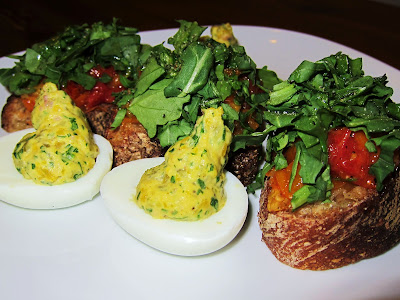 |
| thanks to a few good recipes, of course! |
THOSE of you that know me well know I'm not much of an "entrée" person. In most cases, I'm much happier to order two smaller dishes to equal one main. (if anything, I get to taste more dishes that way) So chances are, you won't find me posting about making coq au vin anytime soon... Yet, in Edouard de Pomiane's French Cooking in Ten Minutes (or Adapting to The Rhythm of Modern Life):
If you like hors d'oeuvres more than anything else, stick up for yourself and make a whole meal composed of nothing but these small delights. ... But don't make this type of meal too often; it will ruin your health.
Well, I just cleared out my Amazon wish list which included: The Tenth Muse: My Life in Food (a memoir dotted with several recipes) and the 1943 edition of The Joy of Cooking. Hopefully, within them, I'll find some recipes for larger dishes that strike my fancy just as much. Until then, two dishes that (over the past several weeks) I've managed to perfect!
 |
| drying some freshly-washed arugula vis-à-vis the Bromberg Brothers Blue Ribbon Cookbook |
Last night, after stopping at PJ Wine for a couple of bottles of wine for the weekend, I began work on what turned out to be a lovely dinner (of small plates) for myself.
 |
| the filling for anchovy and cornichon deviled eggs awaiting egg yolks |
On the menu: roasted tomato, arugula and lemon toasts, from my Blue Ribbon Cookbook and anchovy and cornichon deviled eggs. (I--again--apologize for posting about these dishes again, but as my friend Danny once told me regarding restaurants: You find a place you like and then then it's the only place you go for two years... I'm finding that I may be similar when it comes to recipes)
 |
| still in need of a proper pastry bag |
 |
| I intentionally selected the driest sparkler possible |
On the nose, Zardetto's "private cuvée" smelled of dark fruits. And on the palate: dry--indeed--with a slight hint of mousse-iness and good length on the tongue. The wine paired nicely with the foods and at $9.97, I certainly wouldn't mind enjoying it again!
 |
| beautiful tidbits |
As for the tomato toasts, the arugula did seem to be a heartier option than the parsley was, and it also seemed to be better at retaining sturdiness. (I'd saved one toast and even a day later the arugula was not at all wilted or discolored) However, it is difficult to get the arugula to not fall and tumble off the toasts as you're assembling them--adding them to the chopped tomatoes helps prevent this.
THE only remaining question is: will I be eating tomato toasts and deviled eggs for years to come? The answer remains to be seen. But one of my favorite things about cooking is that leftover ingredients can often lead to other recipes. (HB eggs resulted in finding a recipe for sauce gribiche) Next, I'll need to find a recipe that includes plenty of arugula and a jarful of capers. Salade niçoise, anyone?







































